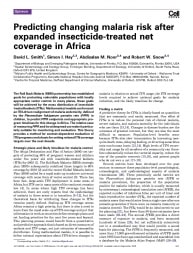May 27, 2010

The Roll Back Malaria (RBM) partnership has established goals for protecting vulnerable populations with locally appropriate vector control. In many places, these goals will be achieved by the mass distribution of insecticide-treated bednets (ITNs). Mathematical models can forecast an ITN-driven realignment of malaria endemicity, defined by the Plasmodium falciparum parasite rate (PfPR) in children, to predict PfPR endpoints and appropriate program timelines for this change in Africa. The relative ease of measuring PfPR and its widespread use make it particularly suitable for monitoring and evaluation. This theory provides a method for context-dependent evaluation of ITN programs and a basis for setting rational ITN coverage targets over the next decade.

